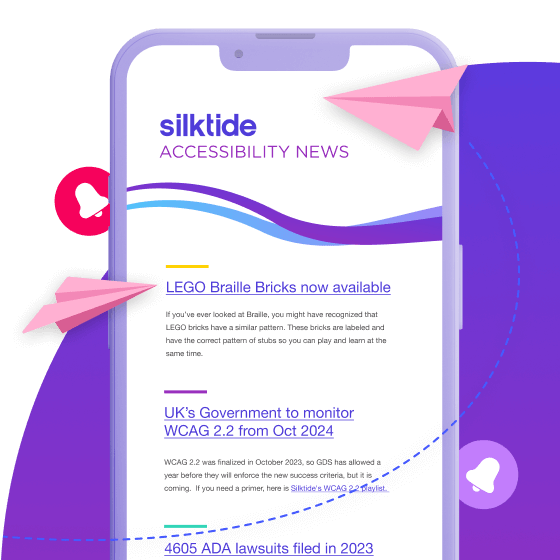If you want to take website accessibility seriously, then manual accessibility auditing is a must.
Whenever I hear the word “manual” I sigh to myself. Mostly because I’m lazy and manual suggests hard work.
But if my years of watching 5-minute craft videos have taught me anything, it’s that there’s always something that makes things easier (usually superglue and plastic bottles).
When it comes to your website’s accessibility testing you probably already use or have considered using an automated testing platform like Silktide.
But if you are, does that mean you don’t need to do anything else? Does it mean that manual accessibility auditing can be ignored? We don’t think so. And here’s why.
Pssst. Don’t worry if you’ve not got the internal resources to do manual testing yourself. We give you some tips on how to do it at the end of the article 😉.
Level up your dedication to accessibility
Manual accessibility testing is carried out by people. And that’s important. Because people have empathy.
Where AI and automation tools see accessibility checks as a box-ticking exercise, a person can actually consider how users with disabilities use your website.
Manual accessibility auditing combines human judgment, empathy, and a deep understanding of accessibility.
They go beyond surface-level assessments and cover your website’s key pages, templates, and forms. The result? Detailed and actionable reports that break down issues and step-by-step guidance for remediation.
You shouldn’t be working to make your website accessible to get another badge on your collar. You should be doing it to make your website a better place for people who use it.
Accessibility audits don’t have to be as boring as they sound
Hearing “accessibility audit” isn’t quite inspiring enough to get me out of bed in the morning. Often it can be pages and pages of spreadsheets and documents that blend into one as you develop a serious case of brain fuzz.
But that doesn’t have to be the case.
With manual accessibility auditing, you can ensure reports are built in a way that is actually beneficial. It’s what we do with our own manual audit reports (spoiler alert! We do manual testing).
Accessibility audits should have clear and concise explanations. Without that, they just aren’t… accessible. Ironic, right?
Protect yourself from legal risks
Legal risk can be scary. But with manual testing, you can accurately find places where your website doesn’t comply with accessibility regulations. That means you can take better protective measures to mitigate risk.
Accessibility is hard. And learning it can take a long time. So using the expertise of a manual auditor with years of experience means you get it right first time.
If you want to find out more about accessibility legislation visit our Glossary, including articles covering the ADA, Section 508, EU Web Accessibility Directive, and more.
Dig deep into your website content
Manual accessibility auditing lets you dig through all your content. From web pages to templates, forms, PDFs, and videos – the benefit of manual audits is that they can look at it all.
But it’s not just about finding where problems lie. Manual auditors give you a detailed breakdown of why the problem is a problem. Then they guide you step-by-step to fix them.
Accessibility testing on actual devices
The best way to test websites for accessibility is by actually using the devices and technology your visitors use.
This includes the usual suspects, desktop, tablet, and mobile – all on different operating systems such as iOS, Windows, and Android. But that’s not all.
They may also test using accessibility technology like screen readers like JAWS, NVDA, VoiceOver, and Talkback.
All of this adds up to a lot of testing and in some cases, knowledge of how to use the technology.
It’s something that would take years of training and experience to gain that sort of expertise in-house. So why not get someone in who already does?
Accessibility testing tips, as promised
At the start of this article, I promised you some tips on how to do some manual testing yourself. Be warned, it’s not easy.
- Learn accessibility
If you want to find accessibility issues on your website then you’re going to need to be able to identify what is a problem. And it’s not going to be a quick Google to find out. Luckily enough you’re in the right place. We’ve got tons of blog articles about accessibility and a YouTube channel full of bite-sized explanations. - Understand WCAG
The Web Content Accessibility Guidelines (WCAG) is a set of guidelines most cited for what is considered “accessible”. There are different versions and different levels of WCAG compliance. Be warned, it’s not an easy read, but you’re going to want to know this stuff. - Use multiple devices and accessibility technology
Just because a page looks good on a desktop, doesn’t mean it’s going to be good on mobile too. And unfortunately, you can even find accessibility problems on one browser, that aren’t there on another. The best thing to do is to test your site using multiple browsers and multiple different devices. You should also try using a screen reader on your site. These can be quite hard to get used to though. Fortunately, we’ve got a handy beginner-friendly field guide that’ll help you get started. - Keep at it
There’s no “right time” to improve your website’s accessibility. Instead, it should be a constant effort. If you’re building or migrating your website, then it’s the perfect time. You can focus on accessibility right from the beginning and save a HUGE amount of time down the line.
By now, I’m sure you’re convinced. Manual accessibility auditing should be part of your workflow. And if you need a hand getting there, let’s talk and see how we can help.

